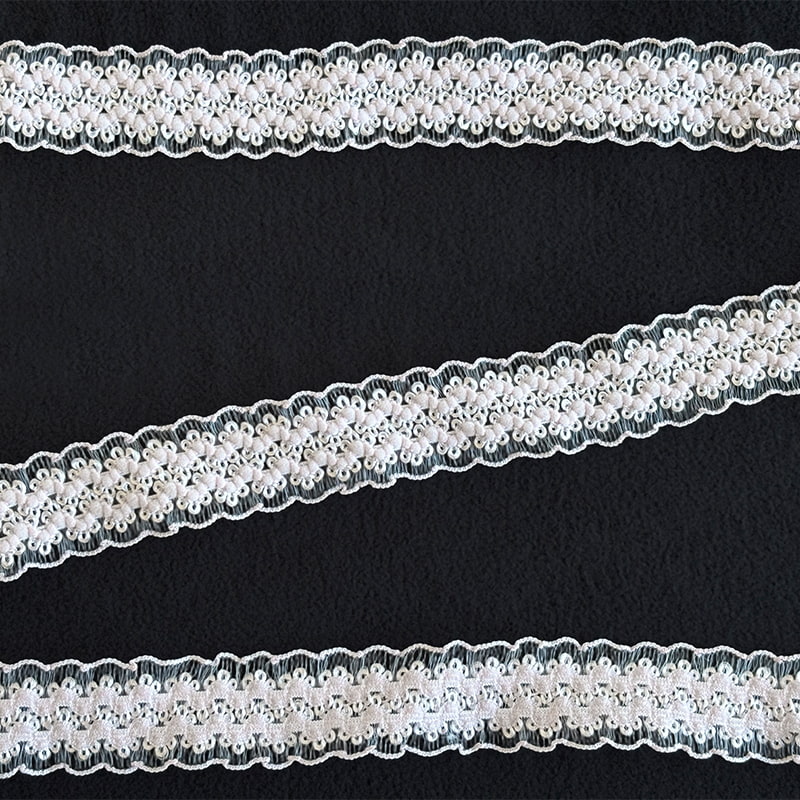In the vibrant world of textiles, there exists a material that holds an enduring place with its unique delicacy and softness—it is lace webbing. Far more than a mere decorative accessory, it serves as a carrier of history, art, and boundless creativity. From the opulent court attire of ancient Europe to the trendy pieces of modern fashion, lace webbing, with its ever-changing forms, has woven its own wonderful narrative across different eras. Light and translucent, it can be either intricately elaborate or elegantly minimal, effortlessly infusing grace and vitality into any object it adorns. Whether in the grand visions of designers or the nimble creations of craft enthusiasts, lace webbing, with its irreplaceable charm, stands as a vital element in the pursuit of aesthetic perfection. Its presence is not just a testament to meticulous attention to detail, but an expression of life attitude, reminding us that beauty often lies hidden within these soft, delicately woven.
Lace Webbing: The Soulful Accent in Wedding Dresses and Formal Attire
On life’s most significant occasions, wedding dresses and formal gowns stand as magnificent symbols of dreams and romance, and lace webbing is the finishing touch that breathes soul into these garments. It is artfully employed on wedding dress hems, necklines, cuffs, or as a waist embellishment, casting a pure and sacred glow upon the bride. Different lace webbing patterns can evoke entirely distinct styles: for instance, elaborate floral lace can craft a classical, palace-like luxury, making the bride resemble a fairy-tale princess; while simple geometric-patterned lace can add a touch of refinement and modernity to a minimalist wedding dress, highlighting the bride’s independence and elegance.
Lace webbing also boasts a diverse range of textures—stiff lace can sculpt a crisp silhouette, while soft lace can drape naturally along the body’s curves, creating a flowing, ethereal effect. It is through such precise control of details that designers, wielding the wonderful material of lace webbing, transform each wedding dress into a one-of-a-kind artwork, allowing the bride to shine most brilliantly on the wedding aisle.

Elastic Lace Webbing: Blending Functionality with Aesthetics
Among the various types of lace webbing, elastic lace webbing has expanded the application of lace with its unique functionality, freeing it from the confines of pure decoration. This type of webbing incorporates elastic fibers during weaving, endowing it with excellent stretch and rebound properties. It is this characteristic that has made elastic lace webbing shine in fields requiring a close fit to the body and comfort, such as lingerie, swimwear, and sportswear.
It retains the inherent beauty of lace while addressing the lack of elasticity in traditional lace, enabling lingerie designs to be more form-fitting and comfortable to wear. In sportswear, elastic lace webbing is often used on trouser legs,cuffs, or necklines, providing necessary tightening function while adding a soft feminine touch, breaking the stereotypical toughness of activewear. The emergence of elastic lace webbing is a paragon of the perfect fusion of function and aesthetics, bringing lace from the realm of traditional grand attire into every corner of daily life and making comfort and beauty no longer an either-or choice.
Lace Webbing as Garment Trims: Elevating Details to Perfection
In the world of fashion design, garment trims, though often regarded as supporting players, play an indispensable role—they determine the final presentation and quality of a finished garment. Lace webbing, as a crucial garment trim, holds such value. It is widely used in various details of clothing: for example, adorning the placket of a shirt, the side seams of trousers, or serving as a belt for a skirt with lace webbing can instantly elevate the garment’s grade and endow it with richer layers.
In children’s clothing design, soft lace webbing is often used to embellish hems or hairbands, adding an innocent and lovely charm to the little ones. In home textiles, too, lace webbing finds its place on the edges of curtains, pillowcases, or tablecloths, bringing a touch of refinement and warmth into living spaces. It can be said that lace webbing is a sharp tool in the hands of designers, with which they carve out details, create endless possibilities, and make each piece exude unique personality and allure. It teaches us that true beauty lies not only in grand compositions but also in those inadvertently revealed exquisite details.
Lace Webbing for DIY: Unleashing Creativity for Everyone
Beyond shining in professional fields, lace webbing is a treasure for DIY enthusiasts. With its ease of use and versatile forms, it opens a door to the world of creativity for ordinary people. You don’t need to be a professional fashion designer to create beauty with lace webbing. For example, using lace webbing of different widths, you can craft one-of-a-kind hairbands or hairpins, adding a touch of sweetness and romance to daily outfits; decorating old photo frames or storage boxes with lace webbing can give them a fresh, vintage artistic vibe; or sewing lace webbing along the edges of plain pillowcases can infuse the living room with softness and elegance.
More creative enthusiasts even weave lace webbing into dreamcatchers, bracelets, or earrings, integrating the lightness and translucency of lace into personal accessories. The joy of hands-on creation lies not only in the beautiful object obtained in the end but more in the satisfaction and sense of accomplishment gained during the process. With its approachable nature, lace webbing encourages everyone to pick up needles and threads, feel the softness of the material with the warmth of their fingertips, and weave their own beautiful life. Its possibilities are endless, waiting to be explored and discovered by every life-loving, imaginative individual.

 English
English Español
Español






